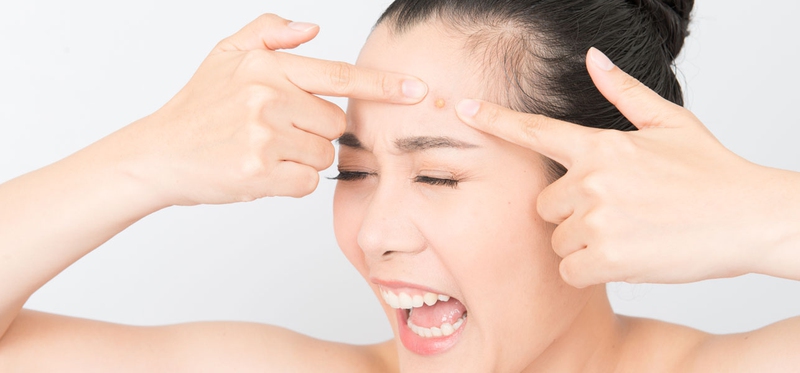Every woman is desirous of a beautiful, flawless complexion. But for most of us this is just a dream. Our complexion gets marred by the appearance of acne that often leaves a nasty scar that is so stubborn that it refuses to go away.
These scars are often the result of inflamed blemishes which are caused by skin pores that are swollen with dead skin cells, excess oil and bacteria. These pores swell, causing a break in the follicle wall. Lesions which are shallow and minor heal quickly. If a deep break in the wall of the pore occurs, then infected material usually spills to the surrounding tissue. This creates deeper lesions. The skin has its own mechanism to repair this by forming new collagen fibres. But the new layer is not as flawless and smooth as the original skin.

Aesthetic Guide on How to Improve Acne Scars
Acne scar treatment
There are a wide variety of clinical treatments for acne scars that include priming creams, chemical peels, microdermabrasion procedures, lasers, etc. Acne scars can be treated with either only peels, only laser or a combination of treatments such as peels, micro needling, light laser and fractional lasers. Sometimes these products are combined along with medication to treat hormonal imbalances such as PCOS/ Hirsutism and other issues that people with severe acne may be dealing with.
Chemical peels
Chemical peels, like glycol and salicylic acid peels, are different peels targeting different skin conditions. These are mild acids which are used to exfoliate and shed the dead skin.
Glycolic acid is a skin care product found naturally. It is a powder or colourless crystals that have no odour. It has a lot of benefits like rejuvenating to moisturizing the skin. A very low percentage of glycolic acid is used in our skincare products which we use daily. Products like face washes and facial cleansers use glycolic acids in them. Glycolic acid is very effective for skin treatments even on sensitive skins.
Salicylic acid is a keratolytic and belongs to the same class of drugs like aspirin. It helps in making skin cells shed by helping in dissolving the substance that makes the cells stick together. It also helps increase the moisture in the skin.
Microdermabrasion
In this procedure, tiny exfoliating crystals are sprayed on the affected skin to remove the outer layer. This procedure makes the skin softer and brighter. It exfoliates and rejuvenates the skin. Usually, severe scars require this procedure. The top layer of the skin is removed by rotating a wire brush repeatedly. This procedure helps to completely remove the scars that are on the surface and the deeper scars become less visible.
Microneedling
This is a collagen induction therapy. This minimally invasive treatment helps to rejuvenate the skin. In this procedure, a device is used with fine needles. This helps to create tiny punctures in the topmost layer of the skin, and helps to trigger the body to create new elastin and collagen. This is an excellent treatment as it helps to reduce scares' size. It also helps to improve the skin texture and its firmness.
Fractional laser treatment
Fractional laser treatment is a non-invasive treatment that works at both the epidermal and dermal layers. This can be used on all skin types and patients. It helps remove old and pigmented epidermal cells and stimulate the collagen remodelling and resurfacing.
Home skin care: Over the counter bleaching agents and sunscreen are prescribed to change the appearance of these acne scars.
Soft tissue fillers: To make the scars less visible, collagen or fat is injected just under the skin, into depressed scars to fill out or to stretch the skin. These results however are temporary, so these injections are required periodically.
Laser resurfacing: This procedure uses a laser to improve the appearance of your skin. It requires the expertise of a dermatologist. The doctor uses a local anaesthesia to help numb the area. General anaesthesia is required if the whole face is being treated. Treating the full face may take up to two hours.
Other energy-based procedures
IPL or Intense Pulsed Light is also known as photo rejuvenation and radiofrequency devices. This treatment can be great for making acne scars less visible without really damaging the outer layer of the skin. However, these results are quite subtle and repeated sessions may be required for optimal results.
Needling or rolling: The underlying tissue is stimulated by rolling a needle-studded device over the skin. It's a very safe yet simple and effective technique for acne scarring. Repeated treatments may be required as the results are subtle.
Punch excision: This procedure requires the dermatologist to cut out the acne scars and repair the wound with skin graft or stitches. Subcision is another technique which involves inserting needles under the skin to loosen the fibres just below the scar.
Botox injections: Acne scars make the skin pucker, so the area is injected with botulinum toxin or Botox to help relax the area, which often improves the appearance of the skin. Repeated injection may be required periodically.
- It is always advisable to discuss these procedures with a doctor before starting any treatment. Each person’s skin reacts differently to different treatments. So it is best to consult a dermatologist before and get to know the pros and cons of the procedure.
- 1.
- 2.
- 3.
- 4.

View All Comments /Add Comment